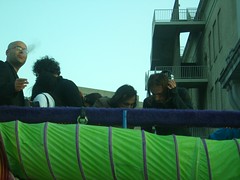I really want to figure out how to make the right production mix to craft classic female leads for vocal trance music. Anyway I’m convinced there’s a formula that has to do with creating a husky, sensual echo sound that must involve multiple vocal tracks in layers.
Well one of the world’s foremost practitioners of trance at the moment, Gareth Emery, mixes a song that he used in a previous mix but lets the whole vocal track play through, unlike in the previous mix. The effect is a totally new understanding of the song’s meaning. Trance, at its best, is like that–equivocal but always intriguing.
Gareth Emery has a podcast that has become my favorite source of new trance music. Too much time is occasionally used for unenthused reading of listener emails, but most of it is good music.
Not that there’s much competition. It’s too bad Trance Tuesday, a more techie style trance podcast from San Francisco, only comes out every few months now. Certainly 2007 is not a high point for trance music, but it is a high point for Gareth Emery, whose podcast #40 exceeded expectations with an excellent hour-long mix set.
Other trance acts worth checking out right now include quirky Danish psy-trance outfit Flowjob and the always-brilliant work of Sander Kleinenberg, Paul van Dyk and Deadmau5 and Fine Taste.

